By SYDNEY J. FREEDBERG JR.
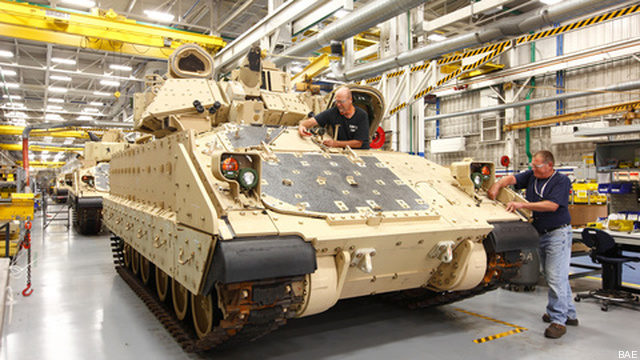 PENTAGON: The figures aren’t final, but the Army hopes to get about $6.8 billion in additional funding for fiscal year 2018 thanks to the recently concluded budget deal, Army Secretary Mark Esper said this morning.
PENTAGON: The figures aren’t final, but the Army hopes to get about $6.8 billion in additional funding for fiscal year 2018 thanks to the recently concluded budget deal, Army Secretary Mark Esper said this morning.
The service’s new plan would start delivering a Next Generation Squad Weapon to the infantry by 2023, replacing the M249 SAW light machinegun and ultimately the M4 carbine and M16 rifle. It would begin fielding a Next Generation Ground Vehicleto armored units by 2030, replacing the M2 Bradley.
Overall, the service’s senior uniformed budgeteer, Lt. Gen. Thomas Horlander, said at a separate event, of the expected 2018 increase, “between 70 and 80 percent of it will be in modernization.” That’s about $4.75 to $5.45 billion.
The budget deal raised spending on defense about $25 billion over the president’s request for 2018, and the Army expects to see more than a quarter of that. But final funding levels won’t be settled until Congress passes an appropriations bill, probably when the current Continuing Resolution expires March 23rd. “I know what we, the Army, would like to see,” Horlander told the Association of the US Army this morning, “but until we actually see a legislated and enacted bill… I can’t tell you with great certainty.”
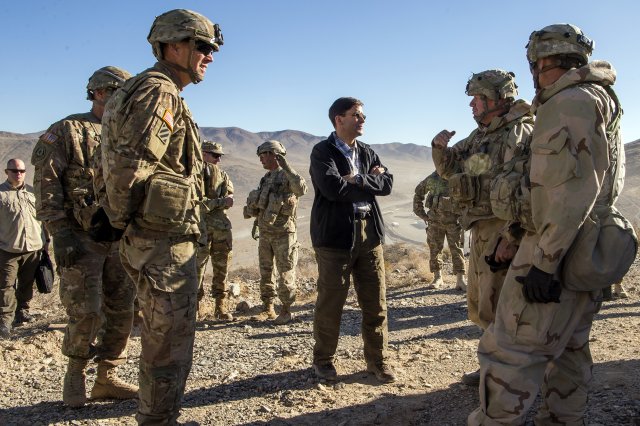 Even after Congress passes defense appropriations and the president signs them, the Army still has to get the money from the Treasury and disburse it to some 35 separate commands and agencies, which then have less than half the fiscal year to spend it. “Once Congress passes it, we don’t get that money immediately, it takes a few weeks, a few weeks, so we could be looking at April…. by the time we start seeing dollars,” Esper said.
Even after Congress passes defense appropriations and the president signs them, the Army still has to get the money from the Treasury and disburse it to some 35 separate commands and agencies, which then have less than half the fiscal year to spend it. “Once Congress passes it, we don’t get that money immediately, it takes a few weeks, a few weeks, so we could be looking at April…. by the time we start seeing dollars,” Esper said.
Army Secretary Mark Esper speaks to soldiers at the National Training Center on Fort Irwin, California
Modernization Wins Big
That the plus-up will emphasize modernization — everything from basic research to upgrading old systems — marks a different course from the service’s overall budget, more than half of which goes to military and civilian personnel. It’s also different from previous plus-ups, which emphasized readiness over modernization. Defense Secretary Jim Mattis always planned to shore up short-term readiness in 2017-2018 and then move on to long-term modernization, and the Army’s emphasis on modernizing for major wars against Russia or China fits well with his new National Defense Strategy. Army Chief of Staff Mark Milley also shored up readiness first before turning to modernization with a sweeping reorganization of the service’s acquisition, R&D, and future concept bureaucracies.
None of this means readiness gets forgotten. To the contrary, readiness remains the Army’s No. 1 priority — but modernization is no longer such a distant second. Modernization probably won’t take first place until after 2022, when the service projects it will meet its readiness goals.
“You’ll see that switch really take place as we hit that ’22 time frame,” Esper said. “We’ll take the gas off of readiness, because we’ll be getting it in a steady state, and we’ll really put the gas down on modernization — but we’ve got to lay the groundwork for that… I don’t want to put so much money into modernization right now that I can’t absorb it and use it well.”
So much of what the Army’s doing now is sowing the seeds of future modernization. As Courtney McBride of Inside Defense reported, the 2019 budget request allocates $38 million of the Army’s rapidly growing RDTE account (Research, Development, Test, & Evaluation) to the Cross Functional Teams working on Milley’s Big Six modernization priorities.
The one and two-star generals heading the eight Cross Functional Teams need their own money to explore the art of the possible: study promising new technologies, experiment with them, conduct technology demonstrations, and — crucially — to build prototypes.
“The primary focus of the CFTs is really to nail down the requirements,” said Esper — the official wishlists of what a new weapons system must be able to do that drive all military procurement. Today, that typically takes the Army “from three to five years,” said Esper, but the CFTs will reduce it “down to 12 months… by doing a lot of aggressive prototyping…. so you fail early and fail cheaply and learn from it.”
“There is money being applied to these CFTs,” Horlander confirmed to reporters after his public remarks to the Association of the US Army here. “You’re definitely going to see them baked in” to the long-range plan or POM (Program Objective Memorandum) for 2020 and beyond. In the near term, it’s possible but difficult to reprogram additional money from other accounts to the CFTs, but that requires both finding someone in the Army to pay the bill and then getting congressional approval: “Those are never really popular, you guys, I’ll just tell you, reprogrammings are really tough to pull off,” he said.
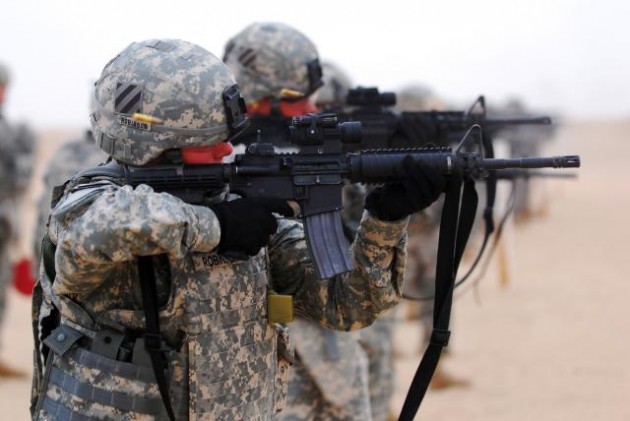 While their funding’s still in flux, the Cross Functional Teams are already highly active, Horlander said. Bypassing the usual bureaucracy, the Vice Chief of Staff and undersecretary of the Army meet with one CFT or another almost every day, he said: “We had two yesterday, we had one last Friday and we had one last Thursday….standing room only.”
While their funding’s still in flux, the Cross Functional Teams are already highly active, Horlander said. Bypassing the usual bureaucracy, the Vice Chief of Staff and undersecretary of the Army meet with one CFT or another almost every day, he said: “We had two yesterday, we had one last Friday and we had one last Thursday….standing room only.”
Soldiers firing M4 carbines
New Tech, Faster
The lowest priority Cross Functional Team, Soldier Lethality, is already accelerating acquisition of new night vision equipment, Esper and other officials have said. That team is looking into everything from better body armor to new computerized training, but “a Next Generation Squad weapon, that would be the big one,” Esper said. “We’re trying to move that forward as well (and) that should happen in the next five years or so.”
A soldier fires his M249 SAW Squad Automatic Weapon in Afghanistan.
There’s a little ambiguity here. The Next Generation Squad Weapon began as the Next Generation Squad Automatic Rifle to replace the M249 Squad Automatic Weapon, a light machinegun issued to two soldiers or Marines in a typical squad. But last year the Army expanded that mission to potentially replacing the Vietnam-vintage M16 rifle and its shorter sibling, the M4 carbine, the standard small arms for the entire Defense Department. My guess is Esper’s “next five years or so” refers to issuing the first replacements for the SAW, with rifle replacements to follow, but I’m still trying to confirm that.
The Army is also leading an all-service effort to replace existing helicopters with something faster and longer-ranged, called Future Vertical Lift, which is Milley’s No. 3 priority. And, after several cancelled programs since 2000, the Army is also exploring a new armored fighting vehicle, the Next Generation Combat Vehicle, which is Milley’s No. 2. (No. 1 is long-range precision-guided cannon shells and rockets). The first FVL variant, replacing the UH-60 Black Hawk utility helicopter, is expected to enter service in the 2030s, but the NGCV timeline has long been fuzzier, with a plan for tech demonstrations in 2022 and first fielding around 2035. Esper wants to change that.
“We’e looking at moving this up now, NGCV prototyping etc.,” Esper said. “I want to see stuff being fielded by 2030.”
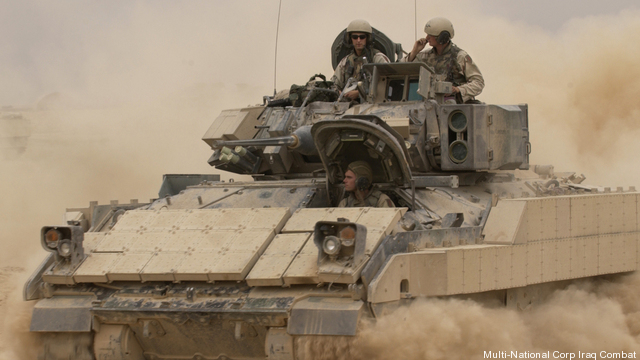 “This notion of somehow we do it in the mid-2030s, I think it’s too late, we need to be more aggressive,” Esper continued. “I think the technology is out there either in our own industry or with other allies (that) we could get to that Next Generation Combat Vehicle — specifically a fighting vehicle, not a tank — sooner than what’s been predicted in the past.”
“This notion of somehow we do it in the mid-2030s, I think it’s too late, we need to be more aggressive,” Esper continued. “I think the technology is out there either in our own industry or with other allies (that) we could get to that Next Generation Combat Vehicle — specifically a fighting vehicle, not a tank — sooner than what’s been predicted in the past.”
M2 Bradley In Iraq
When he says 2030, Esper is talking about a replacement for the M2 Bradley Infantry Fighting Vehicle. The 35-ton M2 looks like a tank, complete with tracks and gun turret, but its primary mission is transporting and supporting infantry. “Tank” in military jargon refers specifically to much more heavily armed and armored Main Battle Tank like the 70-ton M1 Abrams. Both vehicles have been extensively upgraded since their introduction in the early 1980s, but the Bradley is running out of electrical power to feed modern electronics and Active Protection Systems to shoot down incoming missiles.
“Certainly with the Bradley, we are reaching the end of what’s possible with regard to increments (i.e. incremental upgrades), and at some point a little bit later, it will be the same with the tank, so we are being forced to look at what’s after those two,” Esper said.
How big an improvement does Esper want? Is he willing to take risks on cost and schedule in order to get the “10x” (tenfold) improvements in capability sought by Gen. Milley?
“The chief’s message — and I agree with it — is to think big, think bold, but then you have to balance that with, okay, what’s achievable,” Esper said.
While the Army may aspire to revolutionary new technology as a long-term “endstate,” he explained, it must budget for step-by-step improvements along the way there, designing each iteration with room for growth and a plug-and-lay open architecture that can incorporate new technologies as they are ready.
“I’m not going to wait for a big bang,” Esper said. “We need to continue to modernize and do so incrementally….long strides instead of big leaps.”
“I’m not looking for perfect, but I’m looking for better,” he said, specifically compared to “our strategic competitors of Russia and China… better than them.”

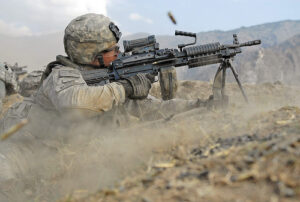

No comments:
Post a Comment